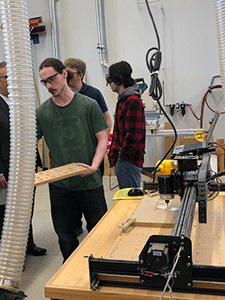SLAM (Students Learning Advanced Manufacturing) held an open house in the STEM shop at Chatfield High School on December 18, 2019. According to Calvin Clemons, MSCS (Minnesota State College Southeast) Director of Trade and Technology, this Open Hour is “an opportunity to meet the inspired teachers, administrators and manufacturers who are creating a vibrant partnership to bring new education opportunities to high school students in southeast Minnesota.” SLAM is a three-year funded NSF (National Science Foundation) grant to “establish a Rural Advanced Manufacturing Education Hub in the Upper Mississippi River Basin.” NSF dedicated $441,951 to the expansion of MSCS efforts to build high school partnerships throughout southeast Minnesota. Chatfield High School and Cannon Falls High School are two hubs that have been established with the college with coursework that started this fall.
The objective of the NSF grant is multi-faceted. It will provide professional development for high school faculty and increase opportunities for underrepresented populations. It gives early exposure to high-tech equipment in the high school setting and relevant workplace learning experience through internships. The grant also would allow for affordable educational pathways to good living wage careers as students could go right to work as an entry machinist or go on for their technical college or AAS (Associate of Applied Science) with some credits already earned. For rural communities it would increase the advanced manufacturing skill talent pool and they could retain and expand their industry base.
Before students demonstrated the CNC (Computer Numerical Control) machines, there was an introduction of the project by both high school principals and members of MSCS. They stressed the importance of this program as a pathway to careers that a high school student may not be aware of other than a four-year post-secondary option. Randy Paulson, Chatfield High School principal, stated that small schools cannot afford the machines that are necessary for such a program. This grant and the support of local manufacturers like Tuohy and E-Z Fabrication allow students to access the training needed. It also gives them college credit from MSCS because their instructor Tim Willette is certified to teach the college credit classes.
Mike Tuohy, representing Tuohy Furniture, is extremely excited about this program for three reasons. One is that it brings back the fundamentals of manufacturing to local students and two, it is a great opportunity for manufacturers; especially helping smaller companies. Thirdly, it is a great opportunity for students to earn a good living after high school. He said there is no ceiling in many positions and they can work their way to even better paying jobs.
Representing students was Brennan Round of Chatfield High School who is dual enrolled in the program and receiving college credit for them. He stated that until he took the ninth grade engineering class and learned of the many opportunities in construction he had not considered this as a career.
The visitors were then invited to watch the machines in progress with students explaining how the machines worked. Students involved in the demonstrations were Alex and Evan Wright, Luke Ihrke, Colby Aarhus, Chance Backer and Liam Palus-Manning. CNC machines are computers that convert a design that has been produced by CAD (Computer Assisted Design) software into numbers. These numbers are like coordinates of a graph and in turn control the movement of the cutter. They were able to watch the CNC plasma cutter cut out rectangles that would be used for a welding assignment, a CNC router that was making a wooden sign, a CNC lathe that was making a bolt and a CNC laser engraver that was carving on wood.
In talking with students it was interesting how they will use these classes in the future. Brennan Round reiterated that until he took the ninth grade engineering class he was going to be a meteorologist but quickly learned of all the opportunities he had in the field of construction. Part of the engineering class was a unit on wiring that changed his career path and he now plans to be a part of the union trades and apprentice as an electrician. Liam Palus-Manning plans to go to RCTC for a degree in Design and Art and took these classes as a backup so if his career in art doesn’t pan out he will have another option. He stated that it would be very easy for him because of the background he has had in high school to go into one of the trades.
Principal Paulson summed up the day by saying, “Now and in the future, the relationships and the shared vision and resources between school districts, technical colleges, and business will become vital in the success of reducing the labor work force gap in the trades and technically skilled jobs.” For students this means the ability to start in the trades immediately after high school or a two-year degree and still be able to advance their careers without a great amount of financial input. It will also give them a substantial living wage.


Leave a Reply